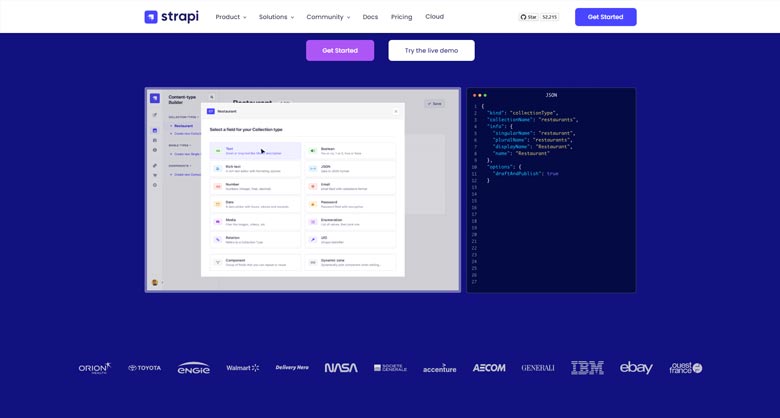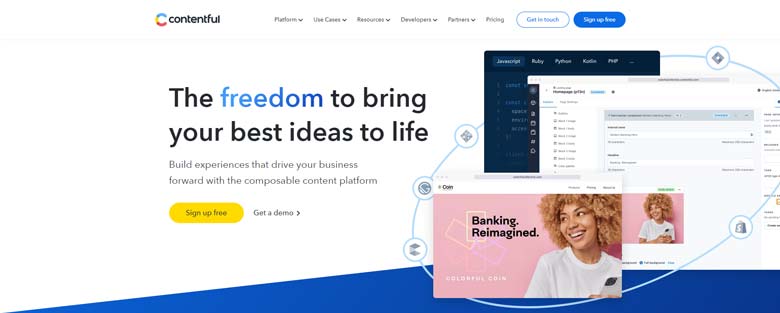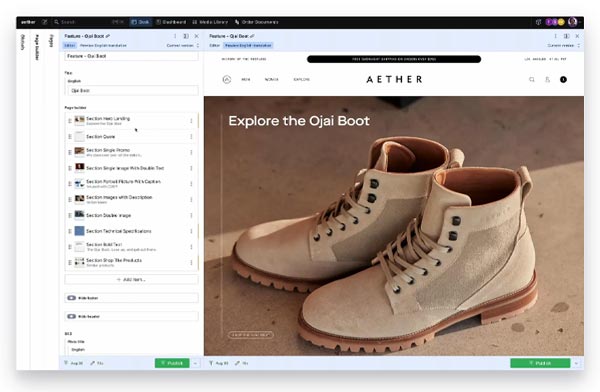The Best Headless CMS (Content Management System) depends on your specific requirements and use case. Headless CMS or Headless content management systems have become a popular alternative to traditional content management systems (CMS) due to their flexibility and scalability.
What is Headless CMS?
Headless CMS is a web content management system that functions primarily as a content repository from the back end. Without a built-in front end or presentation layer, a headless CMS makes content accessible via an API.
What is Headless CMS vs CMS?
In summary, a traditional CMS provides both content creation and delivery in one platform, while a headless CMS only provides content creation and management and allows for more flexibility in delivering content to various platforms.
Best Headless CMS or Headless Content Management System
What is the Best Headless CMS? Below is a list of the Top Headless CMS Platforms:
Strapi – Open source Node.js Headless CMS

What is Strapi?
Strapi is an Open source Headless CMS. It’s 100% JavaScript and fully customizable, saving developers a lot of development time while allowing them to use their favorite tools and frameworks. Strapi also enables content editors to streamline content delivery (text, images, video, etc.) across any device.
What Programming Language does Strapi use?
The best open-source Headless CMS for Python.
Strapi, the best fit with Python. The out-of-the-box Strapi features allow you to get up and running in no time: Single types: Create one-off pages that have a unique content structure.
Is Strapi SEO Friendly?
Now you should probably understand that a headless CMS like Strapi allows you to completely customize your Front-end without compromising on SEO.
Why is Strapi called Headless?
A headless CMS is a content management system (CMS) that provides backend-only functionalities, making content accessible through a GraphQL or REST API and displayable on any device possible. A headless CMS completely separates the backend (creation and storage) from the Front-end (design and deployment).
Integrations
All your favorite dev tools work with Strapi.
Connect your favorite databases, frontend frameworks, or static site generators. Choose where you want to host your websites. Integrate with your favorite tools, and work with the best of each world. No vendor lock-in.
Frontend Frameworks: Gatsby, Vue.js, Nuxt.js, Next.js, React, Angular, Svelte, Sapper, Hugo.
Strapi Features
Build apps fast.
Building customizable, and performant content API has never been easier.
- Open Source
Forever. The entire codebase is available on GitHub and maintained by hundreds of contributors. - Customizable
Easily customize the admin panel as well as the API. Extend your content management with custom plugins, in seconds. - RESTful or GraphQL
Consume the API from any client (React, Vue, Angular), mobile apps or even IoT devices, using REST or GraphQL. - Self-hosted or Cloud
Extend the capabilities of Strapi with Strapi Cloud, our fully managed platform or deploy on-premises, on your favorite public cloud or the PaaS of your choice. You’re in control, no lock-in.
When should you not use a Strapi?
The Drawbacks of Using Strapi
- It’s Difficult to Migrate Existing APIs
If you already have a backend system in place (for example, WordPress), moving it to Strapi will take some time if you want a perfect 100 percent match.
- TypeScript Support Is Limited
Strapi does not support TypeScript out of the box, which is a shame because it is a breakthrough technology. This feature’s absence might make your experience difficult if you’re an experienced user working on a significant or complicated project. However, a plugin in the npm repositories can quickly restore it. You can even write your own plugin for any language since the source code is available online.
- Strapi isn’t Completely Free and Open-Source
Strapi is open-source and free to use; it is not without flaws. However, Strapi offers a Pro version with additional features, such as custom plugin support and priority email support from their team.
- Continuous Updates
Strapi is a tool that is continually updated, so expect frequent updates. If you don’t want your platform to fail suddenly, keep an eye on the weekly updates to Strapi’s stable version. Even though this is now the norm for most open-source tools, it is annoying for developers who like stable software.
Is Strapi a Good CMS?
The comment of one of Strapi’s users: “One of the best Headless CMS I’ve used.” Overall: I use it to provide an API for my Nuxt. js Applications. As it is simple to use, create apis for my applications its not hard to me anymore, since I’ve been start to use Strapi API.
Strapi Pricing: Self-hosted
- Community: Free, forever
- Enterprise: Flexible pricing
Strapi Pricing: Cloud
- Pro: $99/month/project
- Team: $499/month/project
Contentful: More than a Headless CMS

Contentful is one of the Best Headless CMS (Content Management System). You upload your content (text, images, or video) to Contentful; from there, you can organize and edit it as you desire.
What Programming Language is Contentful?
JavaScript, With Contentful you can build highly dynamic JavaScript-based applications in the framework of your choice (Backbone.js, Ember.js, Angular.js, jQuery) or even with pure JS and AJAX requests.
Is Contentful User-Friendly?
The contentful platform offers a very user-friendly approach for beginners. The admin editor interface and content type system are easy to use and work well.
What is the Benefit of Contentful?
Contentful lets you easily store content and deliver it on any device and platform, so developers can focus on writing code and creators on crafting content. This is what content infrastructure is all about.
Contentful Features
- Open-Source
- Well-written documentation, guides, and use cases
- Easy to set up and configure multi-language
- Fully customizable content structure and management UI
- Scheduled publishing, teams, tasks & comments
- RESTful & GraphQL APIs with Global CDNs
- Advanced webhooks configuration
What is the Difference Between Contentful and Strapi?
The main difference between Contentful and Strapi is that the former is a cloud-hosted SaaS while the latter is self-hosted. Think of it as renting a house vs. owning a home. With Contentful, you’re renting a home; that is, you’ll use the vendor’s hosting service.
Contentful pricing
- Free
For developers building individual projects.
Free
Includes 1 Intro space license - Basic
For teams building sites and apps.
$300/month
Includes 1 Intro space license - Premium
For organizations building scaled experiences.
Custom/year
Includes 2 Intro space licenses
Overall, the Best CMS headless depends on the specific needs and requirements of your project. It’s important to evaluate each CMS’s features, ease of use, scalability, and integrations before making a decision.
